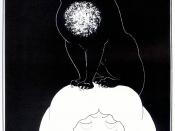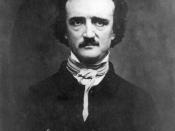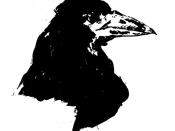In his story "The Black Cat," Edgar Allan Poe dramatizes his experience with madness,
and challenges the readers suspension of disbelief by using imagery in describing the plot and
characters. Poe uses foreshadowing to describe the scenes of sanity versus insanity. He writes "for
the most wild yet homely narrative which I am about to pen, I neither expect nor illicit belief. Yet
mad I am not- and surely do I not dream," alerts the reader about a forthcoming story that will test
the boundaries of reality and fiction. The author asserts his belief of the activities described in the
story when he states "to-morrow I die, and to-day I would unburden my soul"(80).
Poe describes his affectionate temperament of his character when he writes "my
tenderness of heart was even so conspicuous as to make me the jest of my companions"(80). He
also characterizes his animal friends as "unselfish" and their love as "self-sacrificing" illustrating
to the readers his devotion to them for their companionship.
The author uses foreshadowing in the
statement "we had birds, goldfish, a fine dog, a rabbit, a small monkey, and a cat"(80). The use
of italics hints to the reader of upcoming events about the cat that peaks interest and anticipation.
Poe also describes a touch foreshadowing and suspension of disbelief when he illustrates his
wives response to the cat when he writes "all black cats are witches in disguise, not that she was
ever serious upon this point-and I mention the matter at all for no better reason than it happened,
just now, to be remembered"(80).
Poe expresses his early attachment to the cat and dramatizes the character changes he
experiences when he writes "our friendship lasted, in this manner, for several years, during which
my general temperament and character-through instrumentality...


